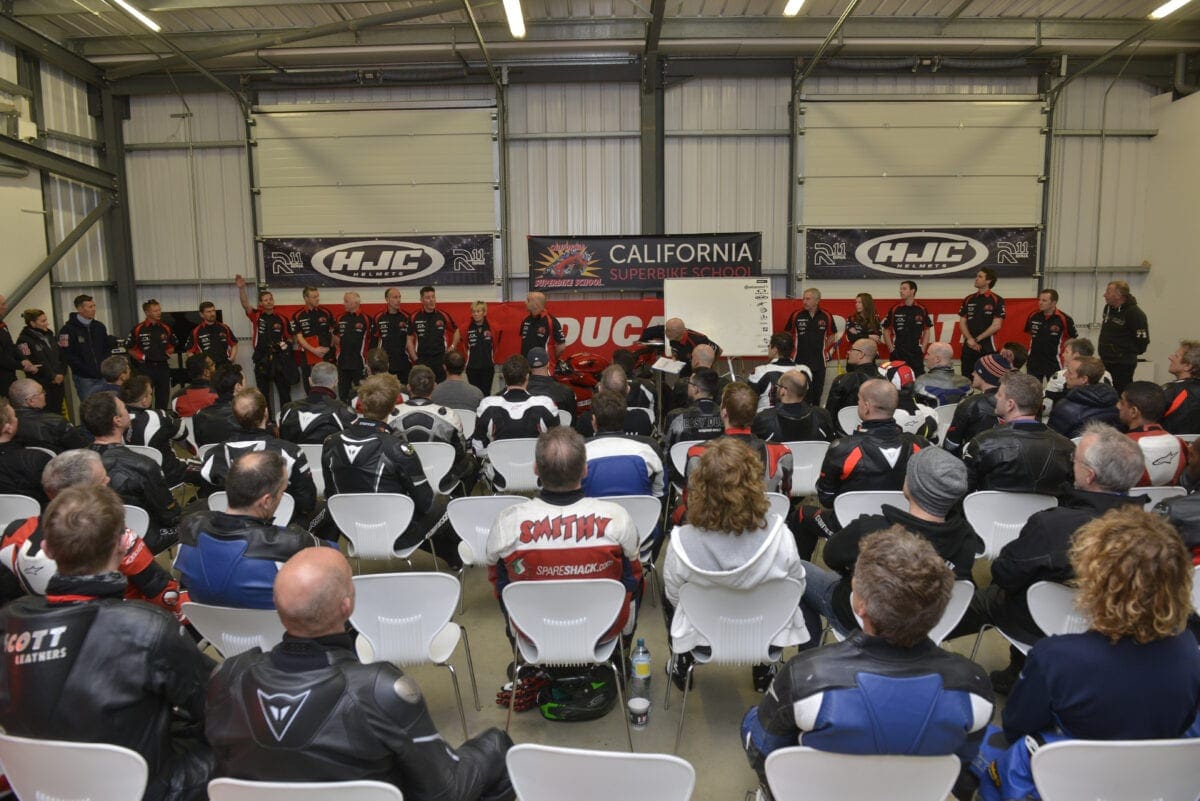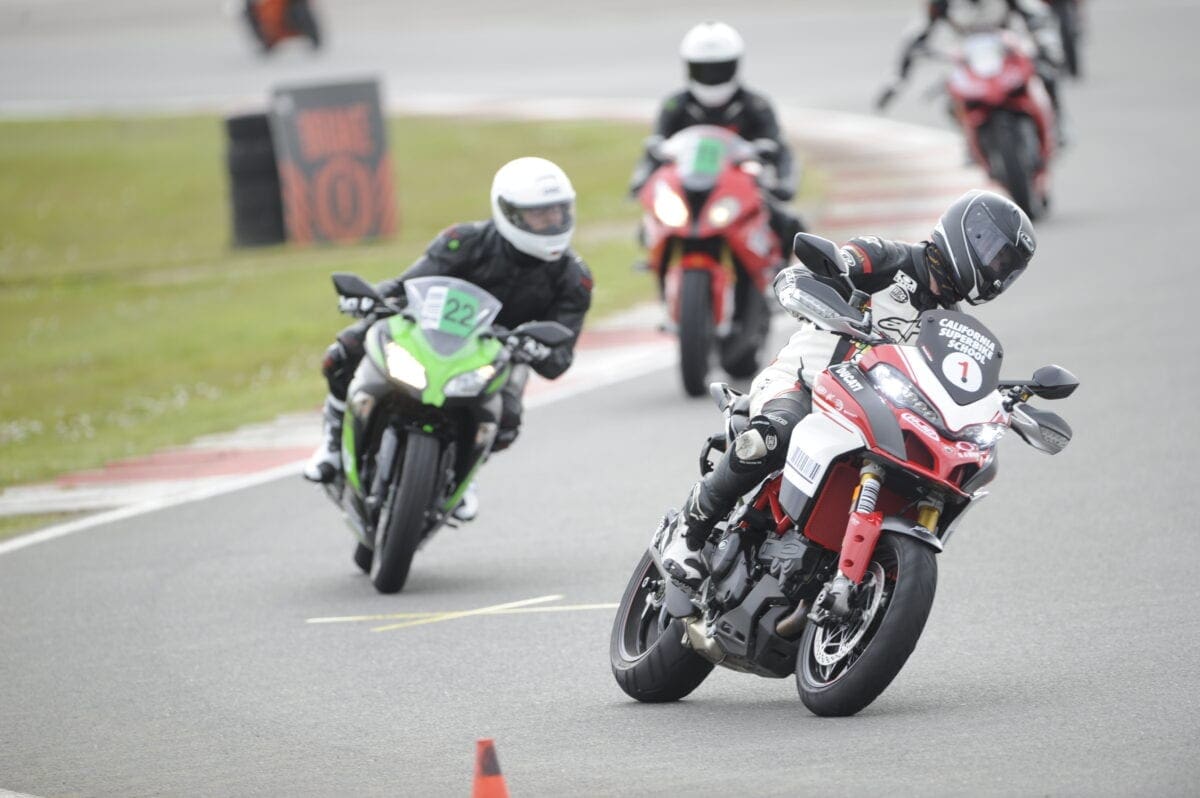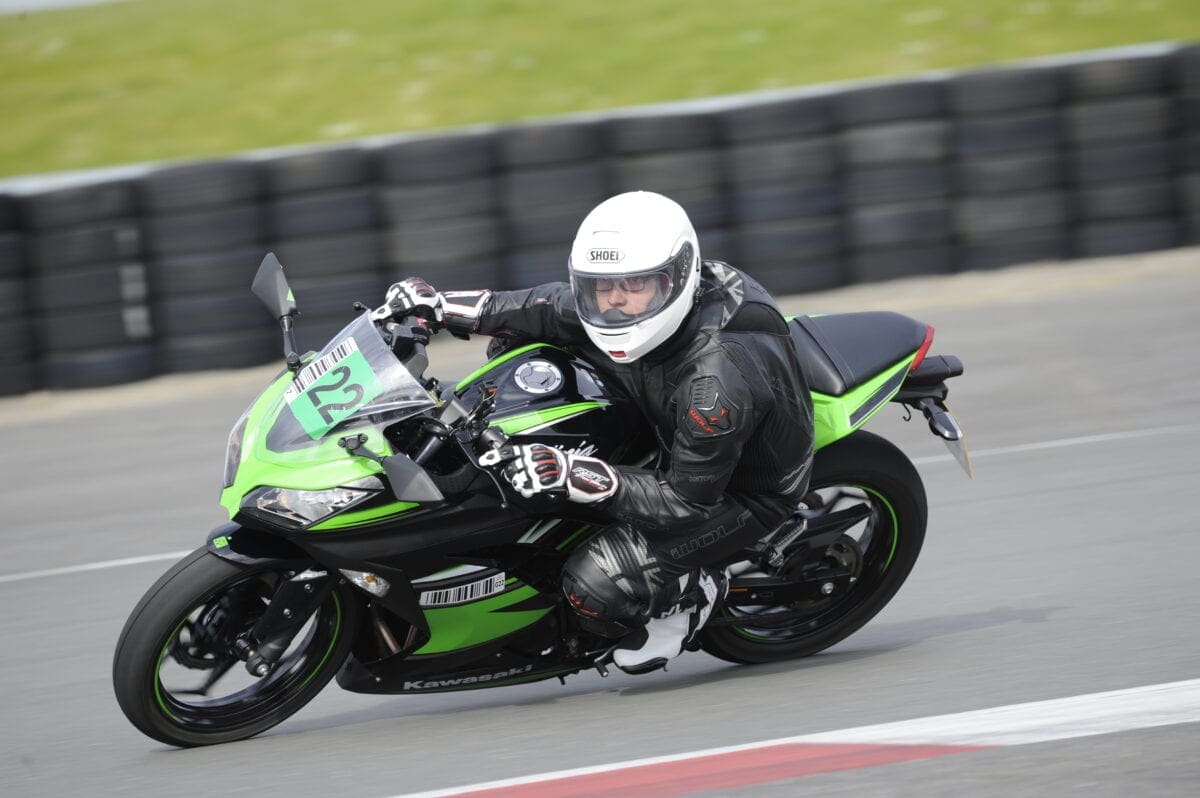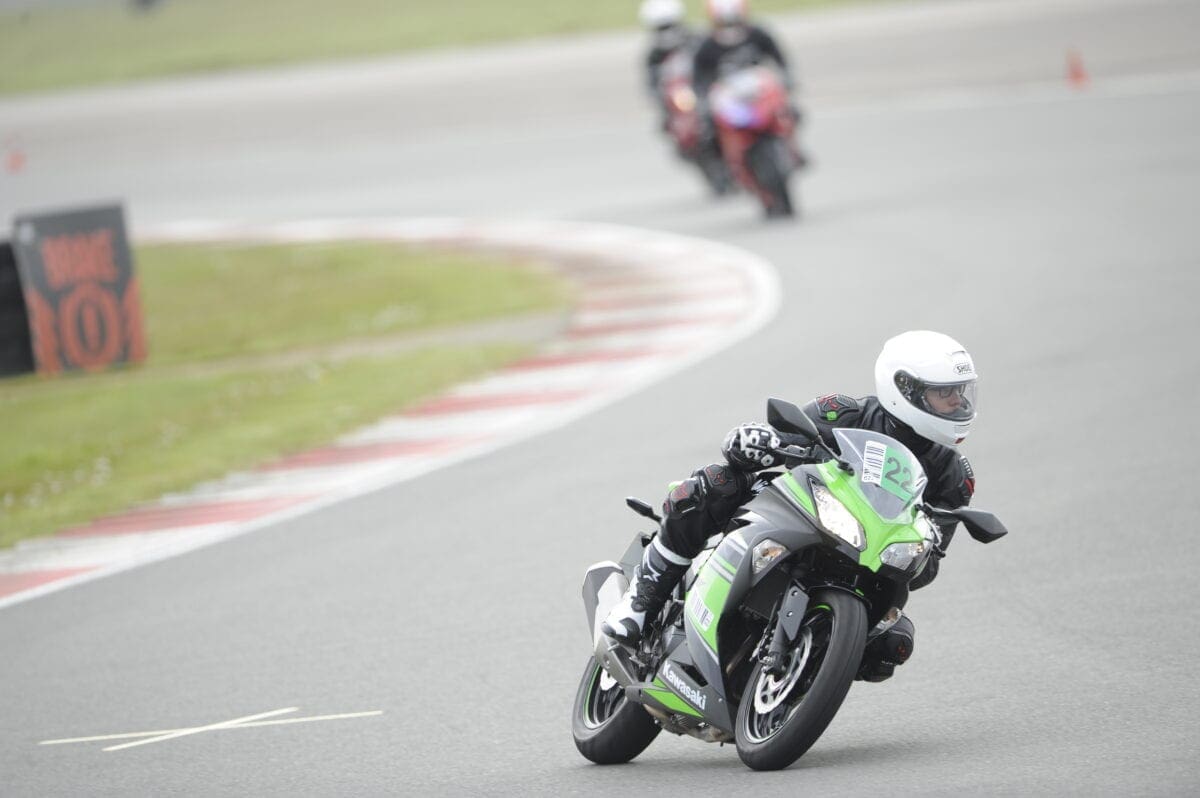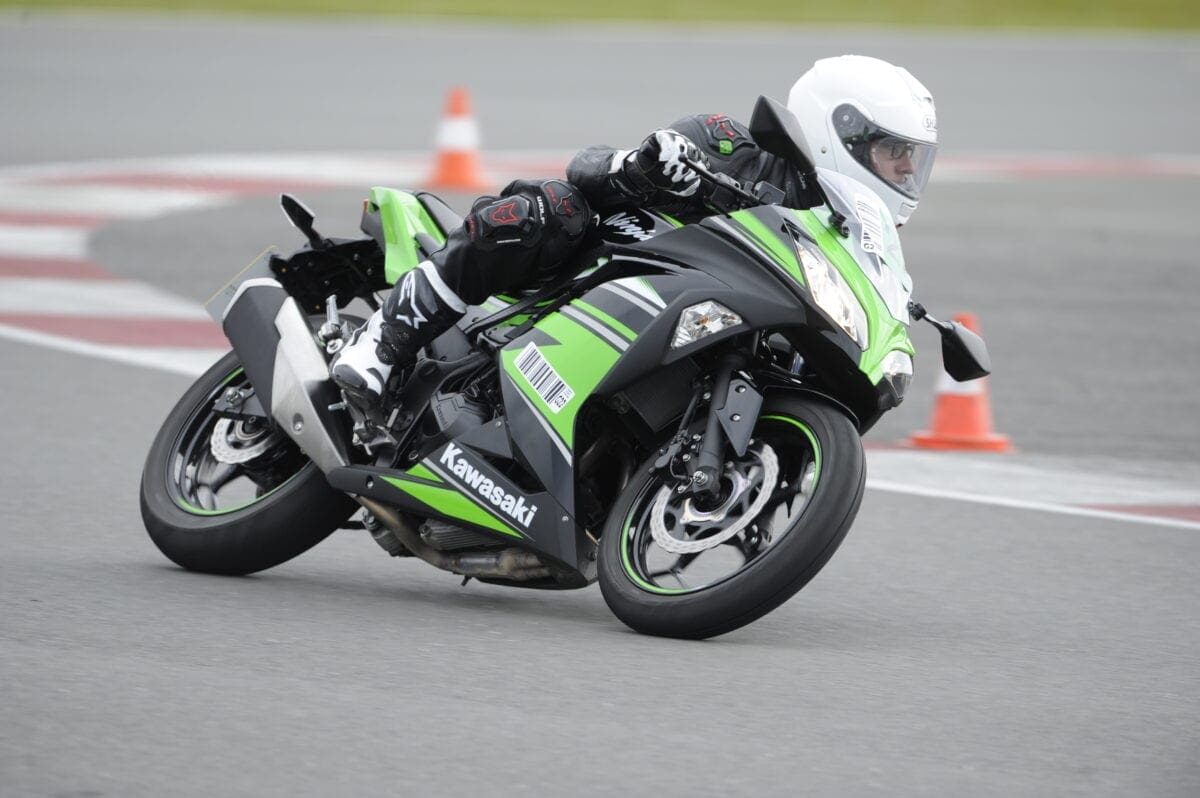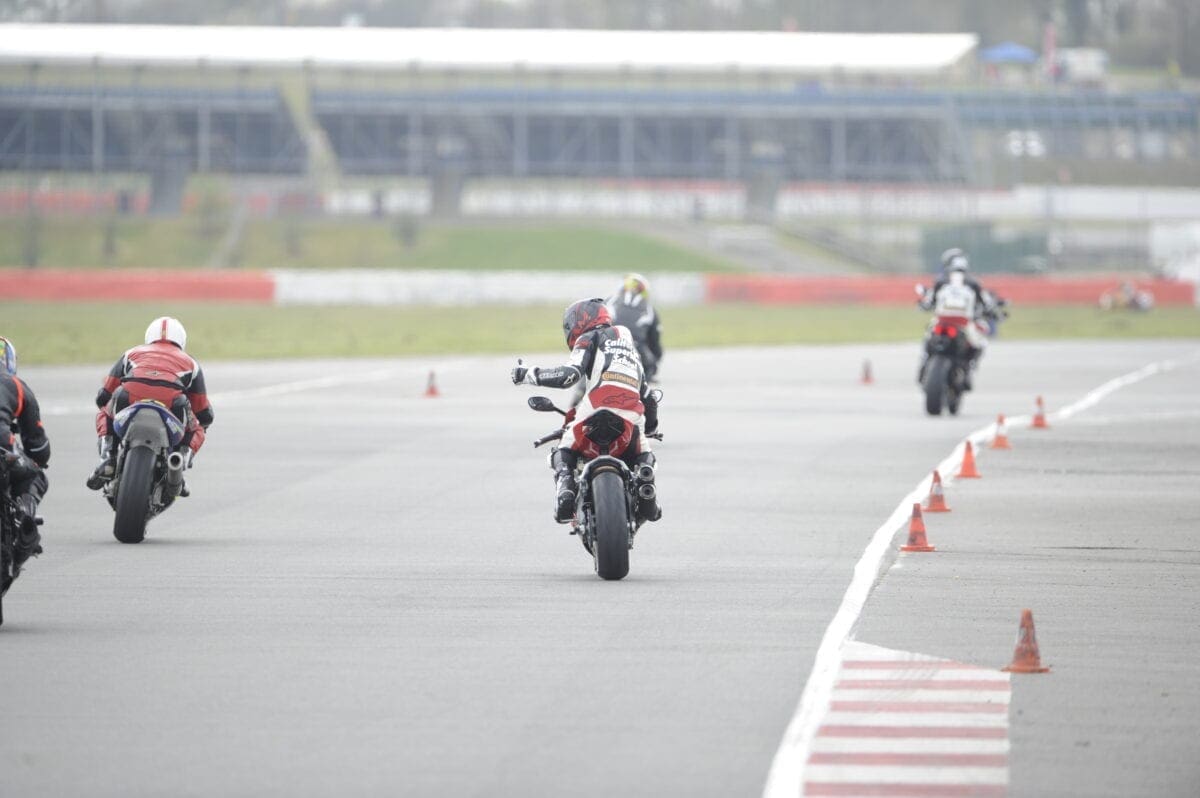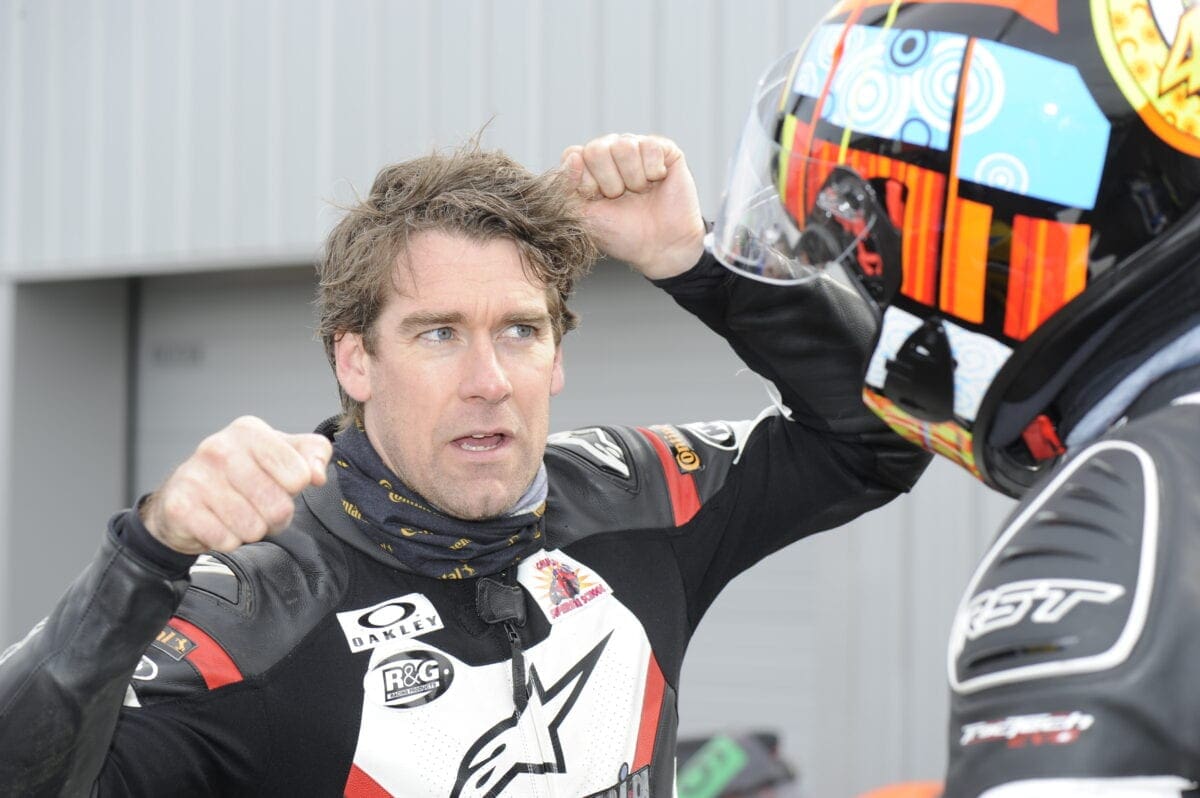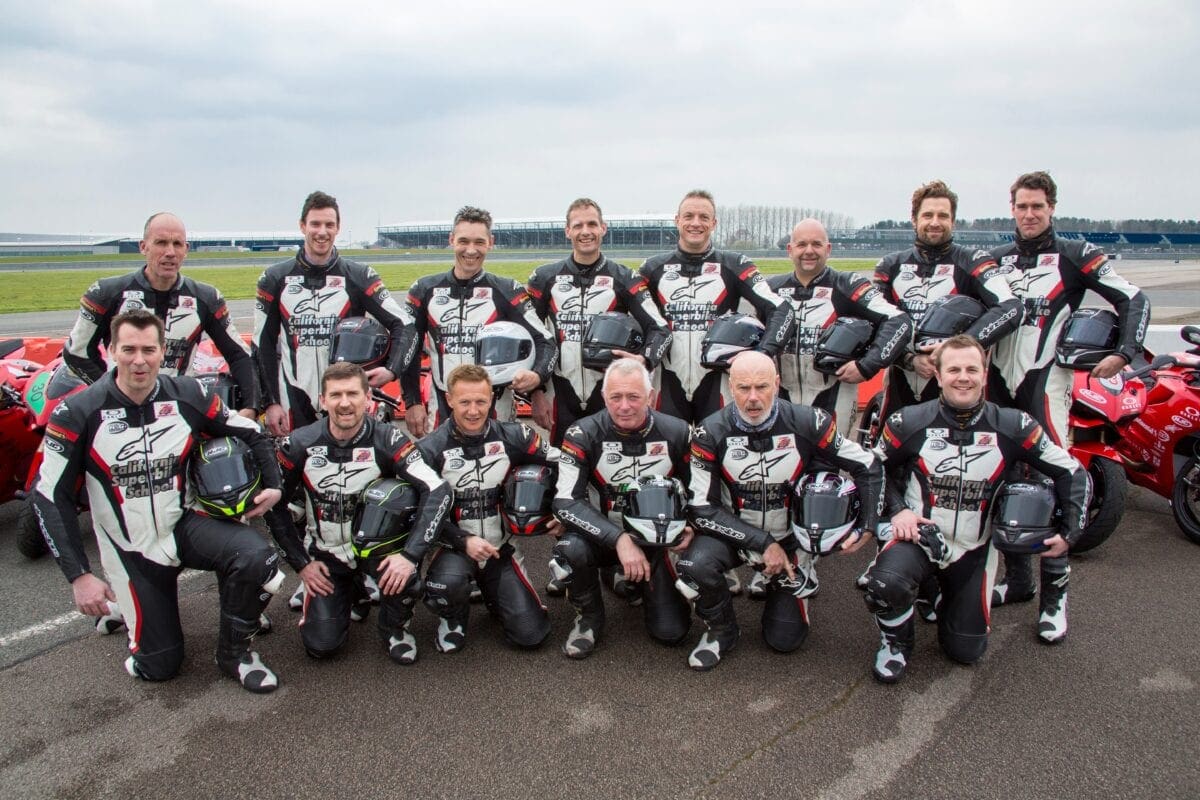The California Superbike School runs rider training in all corners of the world, but in the UK, they use iconic circuits such as Silverstone, Cadwell Park and Brands Hatch. I had booked myself on a course at the Silverstone Stowe circuit. It’s a perfect environment for rider training, offering a selection of different bends and speeds.
The school offers courses from Level 1 to Level 4, with each level tailored to tackle different issues that riders have. You have to complete the levels in order, so I started with Level 1 and hoped for the best.
I headed over to Silverstone on a Kawasaki Ninja 300. It’s a great bike, with enough power to keep up with the bigger machines, while still small and nimble enough to be easily manageable in tight corners. Perfect for what I was going to throw at it.
Early birds
The day started at 7am with registration, as well as bike and kit checks. The guys at the school run a tight ship when it comes to safety, so your bike and all your riding gear needs to be checked before you’re allowed on track to make sure there’s no risk to you or any other participant. It’s great to see that they take rider safety seriously; the last thing you want when you’re concentrating on improving your riding is someone’s bike falling to pieces in front of you.
You need to wear leathers for the training (either a one or two-piece suit is fine) as they offer better protection than textiles. The school has suits for hire if you don’t have one. If you don’t fancy doing the training on your bike, the school has a deal with Ducati, so you could hire a bike for the day. The red hire Panigales looked amazing, but I stayed true to my Ninja.
As the training is done on normal road bikes, there are a couple of things that need to be done to them before the training. The mirrors and speedo are taped over, so you’re not distracted by your speed or by what’s going on behind you. You are also advised to drop the pressure in your tyres a bit for better track performance (they will up the pressures again before people head home at the end of the day).
Getting started
My expectation from the training was that it would be very much based on racing and skills limited to track use, which was slightly daunting considering that I have very little track experience. Luckily, as the day started it soon became clear that the whole day was about stabilising the bike and improving our cornering. The skills involved would be just as useful on the roads as they were on track. Great! This sounded just like what the doctor ordered.
The beauty of practising on track is that there is no other traffic to worry about. No lorries pulling out in front of you, no oncoming vehicles, and no pedestrians. It’s a great environment to simply focus on the job at hand.
The school started with a classroom session that explained the track etiquette, including the different flags and signals. Then we learned more about what we were going to do over the day. It was all going to be about increasing our confidence and skills in cornering, but stabilising the bike. To achieve this, we were going to have five classroom sessions and five track sessions. Each step would add elements to our riding that would add to the stability of the bike. So it wasn’t really about getting the fastest lap or scraping your knee, it was about getting the basics right, which would then result in faster and safer cornering.
Throttle on, throttle off
The first drill was all about throttle control. In the classroom our tutor, Glen, explained how important good throttle control was to keep the bike stable in corners. Applying smooth and consistent throttle at the right time was essential for the suspension to compress just enough for it to be in the optimal working range.
To test the theory we headed out to the track with instructions to use only one gear and no brakes. This session would be spent controlling the speed by rolling on and off the throttle alone. It took a little while to get used to the idea of not braking, but soon it became easier to judge corner entry speeds and the exercise certainly helped me get my throttle hand a lot smoother. Our track coach Duncan rode in front of us and demonstrated with hand signals when to close and open the throttle. This was hugely helpful and made cornering a lot easier without much effort.
After each track session we had a quick debrief with Duncan. The first thing he advised me to do was to shave a bit of speed off and concentrate on the technique to get the most out of the drill. Wise words, as I had been getting a bit excited just to be on track and my speed had probably crept up a bit.
Turning at the right time
The next lesson covered turn points. Now that we had experimented with throttle control and learnt when to open the throttle, we would have big markers on the track signalling the optimal point at which to start turning into a corner. Apparently most people start turning too early, which means they aren’t picking the right line and don’t end up in the right place coming out of the corner.
Once on track, it quickly became clear that I was one of those people who turned too early. It took real effort to wait until the big yellow ‘X’ to start the turn. Again, Duncan rode with us to show exactly where to position ourselves. Slowly I started to build up consistency in turning at the right time, which in turn resulted in my lines being more consistent too. Not perfect, but consistent.
At the debrief Duncan was happy with our progress and asked if there were any corners we wanted to improve our lines in. For me it was the last corner of the circuit, which I always seemed to run too tightly. Duncan’s advice was to try and approach with a little more speed and try to open the throttle a little earlier in the corner. I would be testing that in the next track session.
Turning quicker
After we had found the turning points, the focus turned to turning quickly. The classroom session covered counter-steering, something I had heard about before and even thought I had used. What was a revelation to me was that for really effective turning the counter-steering input (i.e. a push on the handlebar on the side that you want to turn to) needs to be firm and not hurried. I had always just given the bars a quick jab and hoped for the best, so I was excited to test this in practice.
The results of my new-found counter-steering skills were incredible. I could pick the same turning point as before, but achieve a much better line through the corner by using counter-steering correctly. Even the last corner that I had been struggling with was now much easier. It was starting to feel like I was really getting somewhere with my riding. After a few laps of honing my steering, Duncan rode past me with his thumb up, so I guess it must have started to look better too.
Again, Duncan was full of positive encouragement at the debrief and suggested that I try to change my body position on the bike to be more in line with it. This would reduce the lean angle and help me turn easier.
Don’t mess with the bike
We had now covered throttle control, turning points and counter-steering. The next step was to concentrate on getting the rider inputs right. The aim here, as it was throughout the day, was to ensure that the bike remained stable and we didn’t upset the balance. This meant holding onto the bars with a light touch (easier said than done) and instead use our knees to keep us in place on the bike. We were also encouraged to lean with the bike to lessen the lean angle and improve the stability of the bike.
Putting all this into practice wasn’t easy, but once I got more confident and started to relax on the bike I could start to combine all the skills we had learnt on the day. With the right amount of throttle, turning at the right time and using counter-steering, I could put myself in a line that allowed me to relax my hold of the bars and let the bike take care of itself. Using my knees to lock myself in place during braking also helped to keep my hands light on the bars. This is definitely something I need to practise a lot more, but I could see myself improving lap by lap. I was also trying to lean into the corner like Duncan had suggested, which made a big difference in not just how the bike handled, but also in me looking in the right direction almost instinctively.
This time the debrief was pretty quick: “Well done, your body position on the bike was much better now. Wait until you see the pictures of the first session and this one, the difference is clear,” Duncan said. Great stuff, but it did make me wonder how awful I had looked in the first place.
Two-step turning
The last item on the agenda was two-step turning. The idea was to head towards our turning point, then once we were sure we could hit it, we were to turn our gaze into the apex and let our peripheral vision tell us when we were on the turning point and needed to apply steering input. In theory, this would give us good vision through the turn and help us avoid target fixation, a common problem with many riders.
This proved to be the most difficult exercise of the day for me. Whether that was because of the task itself or just that after a full day of riding and learning I was getting tired, I don’t know. I managed to improve but I decided that this would be something to practice later on my own.
The final debrief was a bit of a recap of everything that we had learnt on the day and suggestions of how we could improve our riding further. It was great to have a dedicated track coach, who could give you instant feedback before you forgot what had happened on the track. Knowing that you would be asked questions about your riding also meant that you had to think about it while out riding, which also made you focus on the drills rather than just treating this as a track day.
A giant leap
By the end of the day I was completely blown away by how much the coaches at the California Superbike School had improved my riding in such a short time. I had arrived in the morning as a complete track novice, either over-doing or under-performing most aspects of my riding. I was still a novice, no doubt about it, but my riding had become a lot more controlled, effective and faster than it had been before. And most importantly, I felt like I was riding a bike that remained stable and predictable though the corners, even when I increased the speed.
The way that the school is run is quite remarkable. There are track and classroom coaches, people making sure that everyone is in the right place, mechanics to look after the bikes, a photographer and videographer capturing your progress on film so you can see for yourself how you have improved, and a whole host of people running the show from the wings. For us learners it all translates into a great learning environment, where you don’t have to worry about anything other than improving your riding. The atmosphere is fun, relaxed and welcoming. There is not a trace of the egos that are sometimes associated with track riding.
If you are lacking confidence in cornering, a day with these guys might be just the thing for you. The prices for a single day of training (excluding kit and bike hire) at level 1 start at £415, so it’s not a cheap day out, but the results are real and impressive.
For more information about the California Superbike School, visit: www.superbikeschool.co.uk



